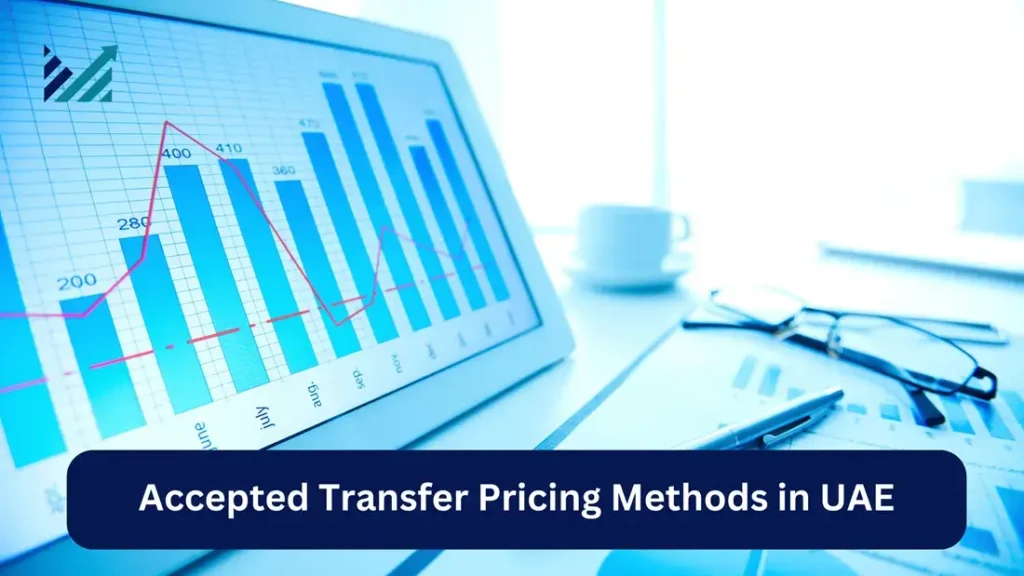
The UAE’s Corporate Tax Law, in alignment with OECD guidelines, recognizes five primary accepted Transfer Pricing methods. These methods ensure that transactions between related parties comply with the arm’s length principle. The Federal Tax Authority (FTA) has outlined these methodologies to provide clarity on how businesses should approach transfer pricing.
Overview of Transfer Pricing Methods
There are five internationally recognized TP methods under the OECD Transfer Pricing Guidelines, which are incorporated into Article 34(3) of the UAE’s Corporate Tax Law. These methods are classified into two categories:
- Traditional Transaction Methods
- Comparable Uncontrolled Price (CUP) Method
- Resale Price Method (RPM)
- Cost Plus Method (CPM)
- Transactional Profit Methods
- Transactional Net Margin Method (TNMM)
- Profit Split Method (PSM)
Traditional transaction methods are generally more straightforward and focus on comparing prices directly between related and independent transactions. In contrast, transactional profit methods assess overall profitability, making them suitable for highly integrated business operations or when limited third-party data is available.
Importance of Transfer Pricing Methods
These methods help determine whether transactions between related parties reflect market conditions as if they were conducted between independent entities. By applying an appropriate TP method, businesses and tax authorities can evaluate whether the pricing of controlled transactions aligns with the arm’s length principle.
Selecting the Most Appropriate Transfer Pricing Method
The selection of an appropriate TP method involves:
- Assessing the strengths and weaknesses of each method.
- Conducting a Functional Analysis to determine the suitability of a method for a particular transaction.
- Ensuring the availability of reliable data on comparable independent transactions.
- Assessing the comparability between controlled and independent transactions, making necessary adjustments if required.
The FTA generally prefers transactional-level pricing methods, though aggregated approaches like TNMM may also be considered. In cases where a single TP method does not provide a conclusive result, combining multiple methods can enhance accuracy.
For instance, if RPM is difficult to apply due to adjustment challenges, TNMM may be used alongside RPM to verify compliance with the arm’s length principle.
Helpful For You: How to Select Appropriate Transfer Pricing Methods?
Determining the Arm’s Length Price
To establish the arm’s length price, the chosen TP method is applied to the tested party, comparing results with comparable uncontrolled transactions.
Choosing the Tested Party
- Reliability: The entity with the most reliable comparable data should be selected.
- Functional Simplicity: The tested party should typically be the entity with fewer complex operations.
Selecting a Point in the Arm’s Length Range
Under Article 34(7) of the Corporate Tax Law, any point within the arm’s length range is acceptable. The FTA considers:
- Reliability of the range used.
- Functional Profile:
- A lower interquartile range may apply to entities with minimal risk and limited functions.
- A higher quartile may be appropriate for entities engaged in high-value functions with significant risk exposure.
Traditional Transaction Methods
Comparable Uncontrolled Price (CUP) Method
The CUP method compares the price of goods or services in a controlled transaction to that of a comparable uncontrolled transaction. If the prices are similar, the transaction meets the arm’s length principle. If significant differences exist, adjustments must be made.
- Advantages: Directly applies market pricing, making it highly reliable when comparable data is available.
- Challenges: Requires close comparability in product type, timing, contractual terms, and market conditions.
For commodities, CUP is commonly used, with publicly available pricing benchmarks serving as references.
Resale Price Method (RPM)
The RPM establishes the arm’s length price by reducing the resale price of a product by the Resale Price Margin and related costs. This method is suitable for distribution businesses with limited value addition.
- Effectiveness: Best for entities that primarily act as resellers without significant intangible assets.
- Limitations: Less applicable when resellers contribute significantly to branding, R&D, or marketing.
Comparability in RPM requires that any differences in functions, costs, and accounting practices between controlled and uncontrolled transactions do not materially impact the results.
Cost Plus Method (CPM)
The CPM calculates the transfer price by adding an appropriate markup to the direct and indirect costs incurred by a supplier. It is widely used for intercompany transactions involving semi-finished goods, contract manufacturing, and shared service agreements.
- Comparability Factors:
- Internal Comparable: Compares transactions between the same entity and an independent party.
- External Comparable: Compares transactions between two independent entities.
For accuracy, both cost structures and functional responsibilities must be comparable across transactions.
Transactional Profit Methods
Transactional Net Margin Method (TNMM)
TNMM evaluates the net profit from a controlled transaction relative to a suitable financial base, such as costs, sales, or assets. It is similar to CPM and RPM but focuses on net margins rather than gross profits.
- Comparability Analysis: Essential to adjust for differences in costs, operating expenses, and market conditions.
- Profit Level Indicators: Commonly used indicators include return on sales and return on assets.
- Best Use Case: Suitable when limited comparable price data is available but functional similarities exist.
Profit Split Method (PSM)
PSM is applied when both related entities make unique and valuable contributions to a controlled transaction. This method splits the total profit of a transaction based on each entity’s relative contributions.
- When to Use:
- When related entities have highly integrated operations.
- When both parties contribute significant intangible assets.
- Challenges: Requires a robust functional analysis to allocate profit fairly.
Documentation and Compliance Requirements
Businesses operating in the UAE must maintain proper transfer pricing documentation to comply with FTA regulations. Key documentation includes:
- Master File: Overview of the group’s global business operations, intangibles, and intercompany transactions.
- Local File: Detailed analysis of related party transactions specific to the UAE entity.
- Country-by-Country Reporting (CbCR): Required for multinational enterprises meeting specified revenue thresholds.
Proper documentation helps businesses justify their TP methodologies and ensures transparency in cross-border transactions.
Seek Expert Assistance
Engaging top auditors in UAE can help ensure compliance with corporate tax laws and mitigate risks associated with transfer pricing adjustments
Conclusion
The UAE’s Transfer Pricing regulations, aligned with OECD guidelines, provide a structured approach to evaluating intercompany transactions. The choice of the TP method depends on the nature of the transaction, data availability, and comparability with independent transactions. Businesses operating in the UAE must carefully assess and document their TP methodology to ensure compliance with the Federal Tax Authority’s regulations and maintain transparency in cross-border transactions.
FAQs on Accepted Transfer Pricing Methods
1. How to select the most appropriate method for transfer pricing?
The most appropriate transfer pricing method depends on several factors, including:
- Nature of the transaction (tangible goods, intangibles, or services)
- Availability of comparable data
- Industry practices
- Regulatory requirements in the country of operation
- Profitability and risk distribution between entities
A company should analyze these factors and choose a method that aligns with the arm’s length principle.
2. What are the five methods of transfer pricing?
The five common transfer pricing methods recognized by the OECD and many tax authorities are:
- Comparable Uncontrolled Price (CUP) Method – Compares prices of similar transactions between independent entities.
- Resale Price Method (RPM) – Uses the resale price of a product and deducts an appropriate gross margin.
- Cost-Plus Method (CPM) – Adds a markup to the cost of production to determine the transfer price.
- Transactional Net Margin Method (TNMM) – Compares net profit margins from similar transactions.
- Profit Split Method (PSM) – Allocates combined profits between related entities based on economic value contributed.
3. What strategies might be used to determine a transfer price?
Companies use various strategies, including:
- Market-Based Pricing: Using external market prices as a reference.
- Cost-Based Pricing: Setting prices based on production costs plus a markup.
- Negotiated Pricing: Allowing divisions to negotiate transfer prices.
- Hybrid Approaches: Combining different pricing methods to ensure compliance and profitability.
4. What are the three general methods for determining transfer prices?
The three general methods are:
- Market-Based Method: Uses external market prices for similar goods or services.
- Cost-Based Method: Uses the cost of production plus a markup.
- Negotiation-Based Method: Involves negotiation between business units to determine a fair transfer price.
5. What are the three main approaches to setting transfer prices?
- Cost-Oriented Approach: Based on costs incurred with a reasonable profit margin.
- Market-Oriented Approach: Based on competitive market prices.
- Negotiation-Oriented Approach: Based on mutual agreement between business divisions.
6. What is the formula for transfer pricing?
There is no universal formula, but common approaches include:
- Cost-Plus Method:
Transfer Price=Cost+(Cost×Markup Percentage)\text{Transfer Price} = \text{Cost} + (\text{Cost} \times \text{Markup Percentage})Transfer Price=Cost+(Cost×Markup Percentage) - Resale Price Method:
Transfer Price=Resale Price−(Resale Price×Gross Margin)\text{Transfer Price} = \text{Resale Price} – (\text{Resale Price} \times \text{Gross Margin})Transfer Price=Resale Price−(Resale Price×Gross Margin) - Comparable Uncontrolled Price Method: Uses market prices of similar transactions as the transfer price.

